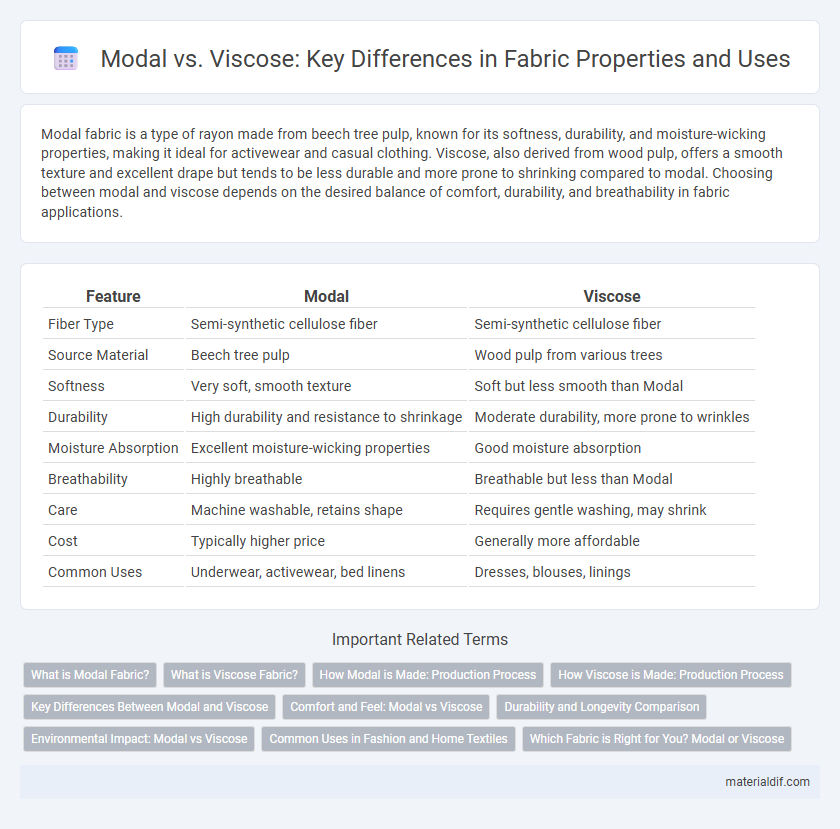Modal fabric is a type of rayon made from beech tree pulp, known for its softness, durability, and moisture-wicking properties, making it ideal for activewear and casual clothing. Viscose, also derived from wood pulp, offers a smooth texture and excellent drape but tends to be less durable and more prone to shrinking compared to modal. Choosing between modal and viscose depends on the desired balance of comfort, durability, and breathability in fabric applications.
Table of Comparison
| Feature | Modal | Viscose |
|---|---|---|
| Fiber Type | Semi-synthetic cellulose fiber | Semi-synthetic cellulose fiber |
| Source Material | Beech tree pulp | Wood pulp from various trees |
| Softness | Very soft, smooth texture | Soft but less smooth than Modal |
| Durability | High durability and resistance to shrinkage | Moderate durability, more prone to wrinkles |
| Moisture Absorption | Excellent moisture-wicking properties | Good moisture absorption |
| Breathability | Highly breathable | Breathable but less than Modal |
| Care | Machine washable, retains shape | Requires gentle washing, may shrink |
| Cost | Typically higher price | Generally more affordable |
| Common Uses | Underwear, activewear, bed linens | Dresses, blouses, linings |
What is Modal Fabric?
Modal fabric is a type of semi-synthetic textile made from beech tree pulp, known for its exceptional softness and breathability compared to traditional viscose. It undergoes a more refined production process that enhances its durability, resistance to shrinkage, and ability to retain color vibrancy after washing. Modal's smooth texture and moisture-wicking properties make it a popular choice for activewear, underwear, and luxury bedding.
What is Viscose Fabric?
Viscose fabric is a semi-synthetic fiber made from cellulose derived from wood pulp, offering a soft and breathable texture similar to natural fibers. It is known for its smooth feel, drapability, and moisture absorption, making it popular in clothing and textiles. Unlike modal, which is a type of viscose with enhanced durability and softness, standard viscose tends to be less resistant to wear and shrinkage.
How Modal is Made: Production Process
Modal fabric is produced using beech tree pulp, which undergoes a chemical treatment to create a smooth, regenerated cellulose fiber through a process called spinning. The cellulose is dissolved and forced through spinnerets to form fibers that are then stretched and washed to increase strength and softness. This eco-friendly production process distinguishes Modal from Viscose, which typically uses a more chemically-intensive approach with wood pulp from various sources.
How Viscose is Made: Production Process
Viscose is produced through a chemical process that transforms cellulose from wood pulp into a soluble compound, which is then spun into fibers. The production involves steeping cellulose in alkali, treating it with carbon disulfide to create cellulose xanthate, and regenerating it into fibers by extrusion through spinnerets in an acid bath. This process differentiates viscose from modal, which undergoes a similar but more controlled method resulting in finer and stronger fibers.
Key Differences Between Modal and Viscose
Modal fabric is a type of semi-synthetic cellulose fiber derived primarily from beech tree pulp, known for its superior softness, breathability, and moisture-wicking properties compared to viscose, which is also cellulose-based but often made from wood pulp like bamboo or eucalyptus. Viscose tends to be less durable and more prone to shrinking and wrinkling, while modal maintains shape and color better after washing due to its higher wet strength. Both fabrics are biodegradable and comfortable, but modal is generally considered a higher-quality, more sustainable alternative to traditional viscose.
Comfort and Feel: Modal vs Viscose
Modal fabric, derived from beech tree pulp, offers a soft, smooth texture with excellent breathability that enhances comfort in warm and humid conditions. Viscose, made from regenerated cellulose fibers, provides a silky feel but tends to be less durable and can absorb moisture more readily, which sometimes affects its comfort in prolonged wear. Both fabrics are lightweight and drape well, but Modal's superior moisture-wicking properties and resistance to shrinkage make it a preferred choice for a comfortable, long-lasting feel.
Durability and Longevity Comparison
Modal fabric offers superior durability compared to viscose due to its higher tensile strength and resistance to pilling, making it ideal for long-lasting garments. Viscose, while soft and breathable, tends to weaken and degrade more quickly when exposed to repeated washing and wear. Choosing modal ensures enhanced longevity and maintains fabric integrity over time, especially in high-use clothing.
Environmental Impact: Modal vs Viscose
Modal fabric is produced using beech tree cellulose through a more sustainable closed-loop process that recycles water and solvents, significantly reducing environmental pollution compared to viscose. Viscose production typically involves chemically intensive treatments with sodium hydroxide and carbon disulfide, leading to higher emissions and deforestation concerns due to its reliance on virgin wood pulp. Modal's increased biodegradability and lower energy consumption during manufacturing contribute to a reduced carbon footprint relative to traditional viscose fibers.
Common Uses in Fashion and Home Textiles
Modal fabric, derived from beech tree pulp, is prized in fashion for its softness, breathability, and moisture-wicking properties, making it ideal for activewear, underwear, and casual clothing. Viscose, a type of rayon made from cellulose fibers, is widely used in both fashion and home textiles due to its silky appearance and versatility, commonly found in dresses, blouses, curtains, and upholstery. Both fabrics offer excellent drape and comfort, but modal's enhanced durability and resistance to shrinking favor its use in high-quality garments, while viscose's affordability and sheen suit decorative home textiles.
Which Fabric is Right for You? Modal or Viscose
Modal fabric offers superior softness, breathability, and moisture-wicking properties, making it ideal for activewear and everyday comfort. Viscose provides a silk-like feel with excellent drape and vibrant color retention, suited for luxurious garments and formal wear. Choosing between modal and viscose depends on your priority for durability and comfort versus elegance and aesthetic appeal.
Modal vs Viscose Infographic

 materialdif.com
materialdif.com